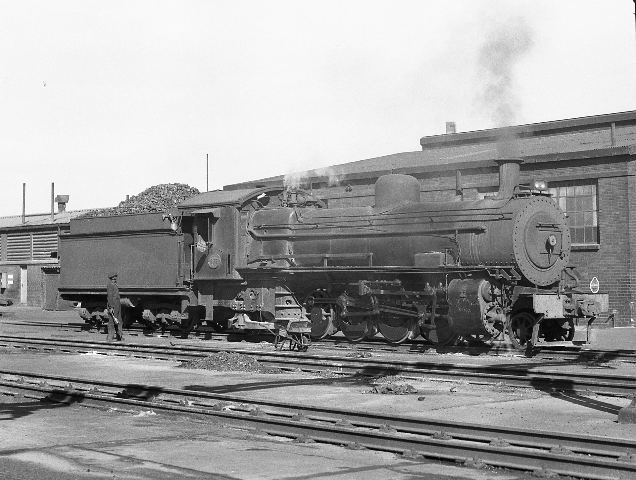Power type Steam | Serial number 16207, 16250-16284 Build date 1904 | |
 | ||
Builder | ||
The South African Railways Class 11 2-8-2 of 1904 was a steam locomotive from the pre-Union era in Transvaal Colony.
Contents
- Manufacturer
- Characteristics
- South African Railways
- Railways
- Industrial
- Modification
- Illustration
- References
In 1904, the Central South African Railways placed 36 Class 11 steam locomotives with a 2-8-2 Mikado type wheel arrangement in service. When these locomotives were assimilated into the South African Railways in 1912, they were renumbered but retained their Class 11 classification.
Manufacturer
Built by the North British Locomotive Company (NBL), the Class 11 was designed for goods train service on the Reef by P.A. Hyde, Chief Locomotive Superintendent of the Central South African Railways (CSAR) from 1902 to 1904. One locomotive, CSAR no. 700, was delivered early in 1904 for trial purposes. After successful trials, this locomotive was followed by a further 35 Class 11 locomotives which were delivered later that same year and numbered in the range from 701 to 735.
Characteristics
The Class 11 was designed by Hyde to take full advantage of the new 80 pounds per yard (40 kilograms per metre) track of the CSAR, which was gradually replacing the old 60 pounds per yard (30 kilograms per metre) sections on mainlines. Upon delivery, however, the class was found to be too heavy for a large part of the existing track and bridges on the line between Witbank and Germiston, where they were intended to work. It took nearly a year to carry out the programme of track and bridge strengthening and some of the new locomotives ended up being held in staging for all that time before the Chief Civil Engineer would allow them to run.
They were superheated, with Belpaire fireboxes. The cylinders were arranged outside the plate frames, with the 10 inches (254 millimetres) diameter outside admission piston valves arranged above the cylinders and actuated by Walschaerts valve gear. The drivers and intermediate coupled wheels were flangeless. The motion, axleboxes and several other details were identical or similar to equivalent parts of the Class 10, which was built at the same time by the same manufacturer, and their Type XM2 two-axle bogie tenders were identical.
The load-bearing springs of the trailing bissel consisted of single helical springs of round section. Since the single spring would not stand up to the load, it was soon replaced by a double spring. Laminated springs were subsequently fitted. Apart from this, the engines were trouble-free and gave more than seventy years of service.
South African Railways
When the Union of South Africa was established on 31 May 1910, the three Colonial government railways (Cape Government Railways, Natal Government Railways and CSAR) were united under a single administration to control and administer the railways, ports and harbours of the Union. Although the South African Railways and Harbours came into existence in 1910, the actual classification and renumbering of all the rolling stock of the three constituent railways were only implemented with effect from 1 January 1912.
In 1912, the CSAR Class 11 locomotives were renumbered in the range from 912 to 947, but their Class 11 classification was retained on the South African Railways (SAR).
The 2-8-2 Mikado type was rare in SAR service, the Class 11 and the narrow gauge Class NG15 Kalahari being the only South African Mikado types to be built in quantity. Apart from these, the SAR had the temporary use on lease of a few Katanga Mikados to alleviate a locomotive shortage during the First World War.
Railways
The Class 11 was initially used on the Reef to haul coal between Germiston and Witbank. They were powerful locomotives which gave good service at moderate speeds, but at higher speed the lightly loaded leading Bissel truck with its 6 long tons 1 hundredweight (6,147 kilograms) axle load proved unsatisfactory on curves.
When more powerful locomotives entered service, the Class 11 was therefore relegated to local workings and shunting duties. In the 1940s, most of them were relocated to the Cape Northern system, shedded at Kimberley, and the Cape Midlands system, shedded at Port Elizabeth, where they were employed on similar tasks until they were withdrawn from SAR service in 1975.
Industrial
Fifteen of the Class 11 locomotives were sold into industrial service, and sometimes resold. All are now withdrawn from service.
Modification
As built, the Class 11 had a gap between the running boards and the walkway in front of the smokebox, with a stirrup-type step attached to the front edge of each running board and without side steps at the locomotive's front. Many were later modified by having slanted extensions added between the running boards and the front walkway to replace the stirrup, and with side steps added next to the leading wheels. Some were modified in this way while still in SAR service, while others were done in various styles by their post-SAR industrial owners, as illustrated below.
While most other SAR locomotives with Belpaire fireboxes were later reboilered with the Watson Standard boilers which were introduced in the 1930s, no Class 11 locomotive ever underwent this modification. They served in the SAR for seventy years, plus several more years in industrial service, while retaining the distinctive appearance which comes with a Belpaire firebox.
Illustration
The main picture and the following photographs illustrate some of the modifications done to the running boards of the Class 11 locomotive, as well as the SAR and industrial liveries which were applied to it.
